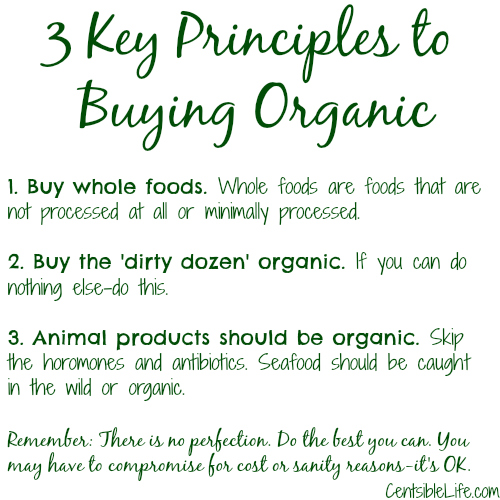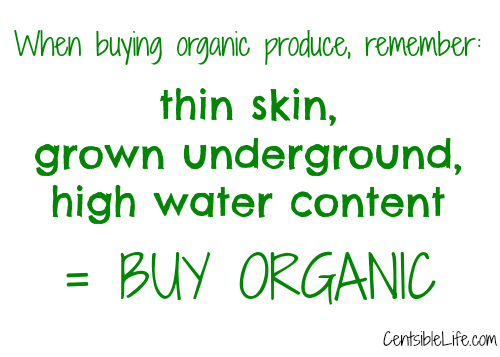Organic food seems expensive. It may seem like a fad. But more and more families are turning to organic food according to a 2013 study by the Organic Trade Association 8 out of 10 parents choose to buy some organic foods. Many for the health benefits, will others choose organics to avoid pesticides, chemicals, and unnecessary food additives. Long gone are the days of it being weird to buy organic food. We’ve entered a new era where organic is accepted, and it has become a way of life for many families.
My Organic Story
In my senior year of high school I became really sick. It started as just not feeling well and being tired but I eventually got to the point where I couldn’t even make it through a typical school day. I would go home early, and eventually I stopped being able to go to school altogether.
No one could figure out what was wrong. Our primary doctor did a multitude of tests that got us nowhere. I saw specialists who couldn’t figure out what was going on. In the meantime I was either sleeping all the time or couldn’t sleep at all, and my body was in so much pain all the time I barely functioned. I was like a zombie.
Eventually after months of doctor visits, scans, blood work, and being unable to go to school I was diagnosed with Chronic Fatigue Syndrome. At the time it was a catch-all for a variety of symptoms that were unexplainable and untreatable. The specialist who finally diagnosed me offered up a cornucopia of drugs to help. antidepressants, sleeping pills, pain medication, and a variety of other drugs that I could try. There was no ‘cure.’
Thankfully my parents and I agreed that was no way to deal with this-and that we’d have to find another way. A friend of my mom mentioned a local Chinese herbalist and recommended I go try them out. As a last-ditch effort we turned to this practice-not knowing if it would do any good.
The first thing the doctor noticed about the abundance of paperwork I brought with me was elevated levels on certain blood tests. They fell within the ‘normal’ range but were close to the top of normal, and they indicated some issues to him right away. In that first meeting and as time went on we learned about the art of Chinese medicine and how the treatment I was receiving was centuries old. The herbs I took in heaping spoonfuls daily were specific to my needs-and often changed from visit to visit. They were based not only on my symptoms but diagnosis by the doctor.
We searched out information in the days before the world wide web was what it is today. I found books, and one became my go to source (Chronic Fatigue Syndrome![]() by Jesse Stoff, MD and Charles Pelligrino, PhD)on getting well.
by Jesse Stoff, MD and Charles Pelligrino, PhD)on getting well.
I began eliminating the crap from my diet, did an elimination diet to find anything I wasn’t tolerating, and eventually started to exercise. I still remember the first time I went swimming. I only made it 4 laps and had to go home and nap after-but it was progress.
I had notebooks full of what I ate, how much I exercised, and took copious notes on how I slept and how I felt each day. It was a long process but it was like a science experiment I was performing on myself-figuring out what made my body run best.
I also started doing home study to complete the classes I was required to have for my degree. In the end I graduated and was even able to walk with my class on graduation day, but it wasn’t easy to miss out on all the senior year fun and friendships.
We started shopping at a local co-op and I got hooked on eating organic food. I dove into learning about foods, and started stocking our fridge and pantry with healthy options.
It took many months of hard work but eventually I made what is considered to be a full recovery and have been in remission ever since. I credit diet, exercise, and of course the Chinese medicine for healing me. I couldn’t have done it though without the support of my parents who never flinched at the grocery bills rising or having a tutor come teach me at home.
20 Years Later
Now 20 years later we still eat (mostly) organic, and I see not only the health benefits and healing it provided me but I see my own kids being extremely healthy because we choose to eat well.
To say that in the last 20 years organic has become ingrained in our culture is putting it mildly. 20 years ago you had to go to a co-op or speciality store to find organic goods and products and often you’d pay through the nose for them! Now you can find them in nearly every grocery store, on many menus, and even at convenience stores. It’s a whole new world out there for eating organic and natural foods!
If you’re new to eating organic or less processed foods I’m hoping my years of experience can help you eat healthier. While we sometimes choose to eat junk-it’s a conscious choice we make knowing that it provides a little balance in our life, and the bulk of our food choices are healthy enough that a little chocolate won’t hurt too much. ![]()
10 Steps to Going Organic

These steps will take some tie, so don’t get overwhelmed. Don’t think you have to do it all at once either. Getting a handle on changing habits takes small steps. It may make sense for you to clean out your kitchen first and then in a week you may tackle making a menu plan and grocery list that includes more organics.
The goal is to take baby steps in the right direction. It’s a time-consuming process at first when you need to learn to decipher food labels, find replacements for family favorites, and learn to shop organic on a budget.
My hope is that these 10 steps will help you get there-if you just keep at it!
1. Check your Cupboards
The first step is to figure out what you already have on hand. You can make a list or a spreadsheet on your computer of what you have on hand if you’re an organization nerd like me. ;)If you have kids at home they can help you read labels, decide what stays and what goes, and count things. (like the 25 cans of tuna hidden way in the back of the cupboard)
- Toss anything that has expired such as spices that are over a year old.
- Donate unopened food to a local shelter, your church, or a family you know in need.
- Read labels on everything. If you don’t know an ingredient, google it. Chances are you won’t want to eat it after that.
- While you are in your cupboards you should take the time to wipe them down. Fill a spray bottle with half vinegar/half warm water to wipe everything down.
Bonus Green Tip: When cleaning out your fridge and cupboards compost anything you can and recycle packaging, too.
2. Clean your Fridge
Now that your cupboards are in order (doesn’t that feel good?), on to the fridge and freezer! If you have more than one start with the one in the kitchen.
- Pull out anything moldy or expired, and check every bottle, jar and container for expiration dates.
- Clean everything off with that same homemade spray.
- Add the items that stayed to your list.
- Continue to clean out until you’ve done every cabinet, cupboard, pantry, and freezer in the house.
Bonus Green Tip: When you tackle this project it might be a good idea to have a “clean out the fridge” dinner where you eat up any leftovers, and food that’s about to expire. This can be a really fun thing to do with kids who can come up with some crazy combinations like apples and ketchup. (true story)
3. Make a List of Staples
Now that you have a list of the things you DO have, make a list of staples you usually rely on and look for more natural or organic alternatives. For instance instead of boxes of cereal buy oatmeal instead. It’s cheaper and healthier.
Your staples should be whole foods (fresh and frozen fruit and veggies), things that store well (nuts, potatoes), and should not include anything like chips, cookies, or bunny crackers even if it is the only thing your toddler eats.
Learning to read food labels is key, and I’ll share a bit more on that soon.
Bonus tip: For an idea of staples, check out Mark Bittman’s staples list.
4. Meal Planning
Now using your lists (staples, what you already have) build some meals. You may need to use your recipe box, or a scour the web and cookbooks for recipes. I recommend checking out Jamie Oliver’s Food Revolution for quick and healthy recipes.
Bonus tip: Use my printable and customizable meal plan to get started.
5. Get To Know Your Grocery Store(s)
Now it’s time to get to know your local grocery stores. On your first trip you’ll have a new set of eyes. You’ll be reading labels, checking prices, and hunting down organic or more natural options.
Bonus Tip: If you don’t have time to visit more than one store each week plan a monthly outing to each store-like visiting Costco to stock up on organic options there, or hitting Trader Joe’s once a month to stock up on frozen goods and condiments.
6. Research Options
Now it’s time to get creative. Using the internet, the phone, and your friends find out what you can purchase locally.
Is there a farm stand down the road from your child’s school or a farmer’s market one town over? {Search for farmer’s markets}
Do you have neighbors, friends, or a community where people grow their own food? You may find help creating your own garden, learn how to container garden, or even score some free seeds, eggs, or even veggies and fruit from someone who has an overabundance to share.
Even in urban areas you’ll find community gardens and folks who use containers to grow their own food.
Bonus tip: One option many people overlook, or don’t know about is a CSA (community supported agriculture) share. You buy a share in a farm, and reap the rewards by getting locally grown organic or low spray fruits and veggies for a fraction of the cost at the store. You’re also supporting your local community to boot! Find local CSAs here.
7. Test Shopping
Set aside time by yourself to go to the store. No kids, no spouse, no distractions. Bring your spreadsheet, or a notepad, a pen, and a calculator or phone that has a calculator app.
For every store that you shop at, you need to find your staples, and write down the prices. This may take a few hours, but it’s a one time thing. If prices fluctuate you’ll know-no more guessing if that $4 gallon of milk is cheaper somewhere else.
Bonus Tip: Use my Grocery Price Book to help organize your prices. Just add in your own info, stores, and staples. This is where you will really save money.
8. What to Buy (my advice):
These are so many choices available it can get confusing. They key is to focus solely on the ingredients list {post on this coming soon}, and what you value. If you can’t live without spaghetti on Wednesdays-don’t.
3 Key Principles to Buying Organic

What We Buy Organic:
Dairy: We buy all organic dairy. If you can’t find organic, find a rGBH-free options. It will say so on the label, and many store brands that aren’t organic include that label.
Meat/poultry/fish: I buy these items in bulk. When buying fish I use this guide to help make an informed decision. There’s even an app for iPhones.
We participate in a buying club for wild Alaskan salmon which is a huge savings. Beef is organic, and grass-fed since the nutrients and vitamin content is higher. I purchase this from the farmer and our local Wegman’s also carries it. Poultry I purchase in family packs at Whole Foods or Wegman’s.
If you can invest in a small freezer you will save a lot of $, but you can easily use your fridge’s freezer by splitting a bulk purchase among family and friends.
Eggs: I buy organic eggs either at the farmer’s market or when we can’t make it we’ll buy them at Wegman’s.
Veggies and Fruit:

Some examples:
- lettuce & celery have high water content;
- potatoes and carrots are grown underground;
- peaches, plums, strawberries have thin skins.
Farmer’s Markets offer better prices (and fresher and more unusual produce) than your local store. You may also find a CSA (community supported agriculture share) where you buy a box of veggies, fruit, or a variety of local goods from a local farmer for the season. In our area that costs about $600 for a full share or $350 for a half share for a total of 7 months or 28 weeks. If you do the math it’s way cheaper than the grocery store.
Grains: Organic is usually the way to go. It’s not a necessity but I wouldn’t skimp on flour, or anything made with flour, or oats. If you can’t afford organic flour, go with a brand that isn’t bleached, bromated, etc. and use whole wheat or a mix of wheat and white whenever possible.
Beans/Lentils/Nuts: I usually go conventional with beans and lentils, but organic and raw with nuts.
Snacks: I buy snack foods for lunches, but we package those into portion bags for ourselves and the kids. However it is way cheaper to buy things as ingredients. Some of our favorite snacks are whole foods- veggies, fruit, yogurt, or nuts. Other great snacks include homemade popcorn, tortilla chips and salsa, or fresh guacamole, and nitrate-free deli meats or pepperoni.
9. Set a Budget
You didn’t think I was going to send you into the store unarmed with a budget did you? I wouldn’t do that to you!
If you did your research you not only know what you’re going to be cooking, what you need to buy, but you also know where the cheapest regular prices will be.
Revisiting your grocery budget at this time is a great way to ensure you purchase enough food for your family and all the meals you want to prepare, and that you aren’t overspending. While organic produce, meats, and dairy are sometimes more expensive you can save big by not buy pre-packaged foods. In many cases you’re buying quality over quantity.
Bonus: Be sure to look for coupons before you shop (click the link below to search for coupons and savings)-even organic foods have coupons! And learn more about how to budget to save even more!
10. Go Shopping
Now time to go shopping armed with your list of things you need, a list of things to avoid and your spreadsheet.
Your list will be personal, and based on your preferences and budget. Below are some ideas on ways to save in different categories.
The key to saving money on groceries isn’t just about lowering your bill, you save money by making choices about what you value. If you value having fresh produce over buying meat, you may spend slightly more on organics, but balance that by buying less meat.
Now unpack the groceries, and get cooking!
Handy Pocket Guides
Organic produce guide: Choosing your produce at the market just got easier!
Regional Safe Seafood Guide: Choose your region and download and print a wallet sized card of what to eat, and what to avoid. They also have an app for that. Amazing what your phone can do now.
Do you have any advice for going organic?
If you like this let me know since I have plans to add a post on my pantry staples, cookbooks we use, and a how-to on reading food labels.
Kelly



























Pingback: 10 Steps to Going Organic on a Budget | Rosy Pink Cheeked